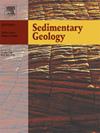Analysis of lake level fluctuations in the Early Cretaceous Songliao Basin supports aquifer eustacy
IF 2.9
2区 地球科学
Q1 GEOLOGY
引用次数: 0
Abstract
Clear geochronology and precise interpretation of sequence stratigraphy enhance our understanding of continental lake-level evolution. The Songliao Basin features well-preserved Cretaceous continental strata. Nevertheless, the correlation between lake-level fluctuations and global sea-level changes remains ambiguous. High-resolution gamma ray logging data were used to analyze the cyclical stratigraphy of the lower member of the Early Cretaceous Shahezi Formation in the Songliao Basin. X-ray fluorescence experiments characterized the sedimentary environment of this formation. Lake-level variations in the lower part of the Early Cretaceous Shahezi Formation were reconstructed using sedimentary noise modeling based on finely tuned gamma ray logging data. Time series analysis using the tuned gamma ray data established an astronomical timescale of approximately 2.4 Myr within the lower section of the early Cretaceous Shahezi Formation in the Songliao Basin. A volcanic ash layer dating (118.20 ± 1.5) Ma from the base of the Shahezi Formation served as an anchor point, providing an absolute astronomical timescale ranging from 115.80 to 118.20 Ma for the study region. The sedimentary model indicates that variations in paleowater depth within the lower section of the Shahezi Formation closely match fluctuations observed in the Fe/Mn index, which reflects paleowater depth changes. This introduces a novel approach to assess changes in continental lake levels. The sedimentary noise model revealed a notable obliquity cycle of about 1.2 million years, strongly associated with fluctuations in lake levels. This indicates that prolonged obliquity periods affect lake level variations. Intriguingly, when lake levels rise, global sea levels concurrently decline, highlighting an inverse relationship between these phenomena. This observation offers insights into how long-term obliquity-driven climate changes regulate sea and lake levels.
早白垩世松辽盆地湖泊水位波动分析支持含水层生态性
清晰的地质年代和序列地层学的精确解释增强了我们对大陆湖泊水位演变的理解。松辽盆地的白垩纪大陆地层保存完好。然而,湖泊水位波动与全球海平面变化之间的相关性仍然模糊不清。利用高分辨率伽马射线测井数据分析了松辽盆地早白垩世沙河子地层下部的周期地层。X 射线荧光实验描述了该地层的沉积环境特征。根据微调伽马射线测井数据,利用沉积噪音模型重建了早白垩世沙河子地层下部的湖泊水位变化。利用调谐伽马射线数据进行的时间序列分析确定了松辽盆地早白垩世沙河子地层下部的天文时间尺度约为2.4百万年。以沙河子地层底部的火山灰层年代(118.20 ± 1.5)Ma为锚点,为研究区域提供了115.80-118.20Ma的绝对天文时间尺度。沉积模型表明,沙河子地层下段古水深的变化与铁/锰指数的波动密切相关,而铁/锰指数反映了古水深的变化。这为评估大陆湖泊水位的变化提供了一种新方法。沉积噪音模型揭示了一个约 120 万年的显著钝角周期,与湖泊水位的波动密切相关。这表明,长时间的纬度倾斜会影响湖泊水位的变化。耐人寻味的是,当湖泊水位上升时,全球海平面也同时下降,凸显了这两种现象之间的反比关系。这一观测结果为了解长期纬度偏差驱动的气候变化如何调节海平面和湖泊水位提供了启示。
本文章由计算机程序翻译,如有差异,请以英文原文为准。
求助全文
约1分钟内获得全文
求助全文
来源期刊

Sedimentary Geology
地学-地质学
CiteScore
5.10
自引率
7.10%
发文量
133
审稿时长
32 days
期刊介绍:
Sedimentary Geology is a journal that rapidly publishes high quality, original research and review papers that cover all aspects of sediments and sedimentary rocks at all spatial and temporal scales. Submitted papers must make a significant contribution to the field of study and must place the research in a broad context, so that it is of interest to the diverse, international readership of the journal. Papers that are largely descriptive in nature, of limited scope or local geographical significance, or based on limited data will not be considered for publication.
 求助内容:
求助内容: 应助结果提醒方式:
应助结果提醒方式:


